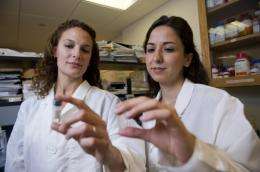Fat for better drug function

Scientists have long known that food digestion affects the way the body absorbs various compounds—from nutrients to drugs and toxins.
“You can get multiple hundreds of percent improvement in bioavailability if you dose a compound in the presence of a high fat molecule,” said Rebecca Carrier, an associate professor of chemical engineering at Northeastern University.
The problem with that approach, however, is that its unpredictability prevents doctors from using that knowledge to reduce drug dosages and improve drug delivery. “We don’t know when it’s going to happen and when it’s not going to happen,” Carrier explained. “It’s not amenable to any form of quantitative prediction at this point.”
But that may soon change.
Carrier has recently received a $1.8 million grant from the National Institutes of Health with the hope of understanding the mechanisms behind this phenomenon. “We want to develop predictive models for how ingested lipids, or fat molecules, change the way your body absorbs different compounds,” she said.
Drugs and nutrients, such as vitamin B6, are often insoluble in water. Since approximately 50 to 65 percent of the adult body is made up of water, these compounds have a hard time making their way into the blood stream. When lipids are nearby, they engulf these compounds and increase their solubility.
As Carrier put it, “When you ingest something, it changes the environment that the drug molecule sees.”
The project will benefit from the expertise of two other Northeastern faculty members—Mansoor Amiji, Distinguished Professor and Chair of the Department of Pharmaceutical Sciences, and David Budil, associate professor of chemistry and chemical biology and associate dean for research in the College of Science.
Amiji will assist the Carrier group with understanding the relationship between laboratory results and phenomena in the body. Budil, for his part, will use his expertise in chemical analysis to help Carrier track the location of the body’s drug molecules.
Budil’s work will examine the body’s overall absorption of drugs, but the phenomenon is a culmination of many different factors, including gastrointestinal mucus.
Exploring the properties of the GI mucus barrier is the focus of another of Carrier’s projects, which is being supported by a different NIH grant. Carrier noted that the properties of the GI mucus barrier “are significantly modulated by stimuli associated with eating.”
“GI mucus is a very interesting hydrogel,” she added. “It is able to protect you from this crazy environment of millions and millions of microorganisms yet efficiently allows absorption of all the compounds you need.”
Provided by Northeastern University




















